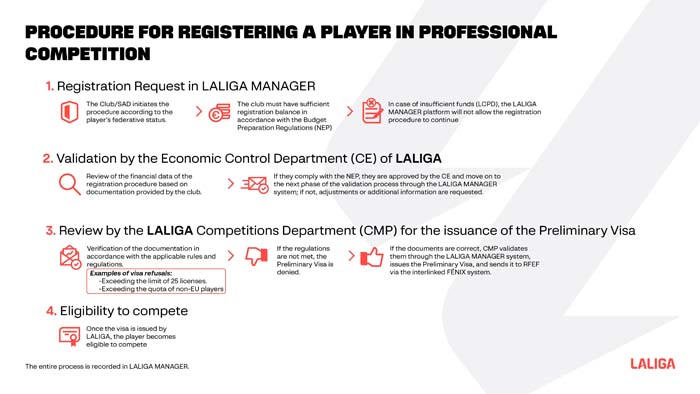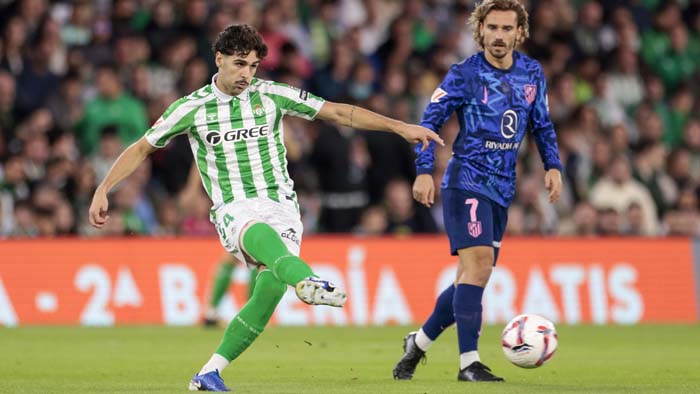Summer is traditionally the time for football transfers. When clubs reinforce and make the necessary adjustments to their squads for the upcoming season. Click this link https://a.meridianbet.ke/c/C7pYjz to start gaming and stand a chance of winning big with Meridianbet.
A period of excitement and hope for the fans. But how does the process work from the inside? What should a club do before signing a player to register them in LALIGA? What do Financial Control and the Squad Cost Limit approved by LALIGA consist of? This is how the transfer market works behind the scenes in LALIGA:
Financial Control is a regulatory framework that was self-imposed by the LALIGA clubs and public limited sports companies (SADs) in 2013, with the firm aim of ensuring the sustainability of the competition and its own clubs through the review of financial situations. It applies to LALIGA EA SPORTS and LALIGA HYPERMOTION, so all participating clubs must comply with the same rules. Its peculiarity is that it is preventive in nature: control is carried out a priori. Moreover, this a priori control coexists with a whole body of ex post economic control rules, inspired by UEFA’s Financial Sustainability (formerly Financial Fair Play). Thus, clubs are aware of how much they can spend in advance, which means they can more easily comply with their limits, thereby avoiding the creation of unsustainable debt. It is a distinguishing measure among the five major European leagues when facing the transfer market.
In this sense, when making signings, one of the pillars within Financial Control is important: the Squad Cost Limit (SCL). That is, the total amount that each club can spend on its squad, both the Registerable and the Non-Registerable. The Registerable squad includes players with numbers 1 to 25, coach, assistant coach, and physical trainer, all from the first team; but also, players not assigned to any club team or even no longer part of it but who still incur some cost (for example, severance pay). And the Non-Registerable squad includes all other players and technicians of the club, including reserve/affiliate teams or other sports sections.
And it does not only affect the salaries of these professionals but many other factors: variable remunerations, image rights, agent costs, amortization of transfer rights, loan costs, Social Security, severance pay, 25% of the buy option price (when it is highly likely to be fulfilled), license fee, and other remunerations. So any new player to be registered must be able to fit within the club’s SCL.
Taking into account all these items within what is understood as Sports Squad Cost, each club’s limit corresponds to a simple equation: budgeted income minus budgeted non-sporting expenses, also taking into account debt repayment, as well as losses that must be recovered in that season. The resulting amount is the club’s SCL.
Thus, based on the SCL, when a new player is signed, the club or SAD sends all the documentation of said player to LALIGA, who authorizes or denies at that specific moment the registration, in accordance with the rule and the SCL updated to the date of said registration. In this regard, there is a Validation Body that, using reports from independent experts and rules established in the Norms, can adjust any operation, for example, to ensure that such operations are consistent with market value and/or economic sense. So it is guaranteed that all players registered by all LALIGA clubs comply with Financial Control. Only then is there a guarantee that all teams play by the same rules, that there is no financial doping in any of its forms and, above all, the sustainable growth of LALIGA clubs.
The success indicators in the application of this Financial Control together with the responsibility of the clubs themselves are indisputable. Debt with Public Administrations has been reduced from 650 million euros in 2013 (mostly overdue) to barely 3 million euros currently (all up to date). Similarly, the amount of unpaid wages to players has drastically fallen from 89 million euros to 0 euros.
Since the implementation of Financial Control, these off-field results have also been accompanied by successes on the pitch: 21 of the last 39 European titles in this period belong to Spanish clubs. Every player playing in LALIGA knows that they are in a competition of sporting strength and financial stability.

Which bodies are involved in setting the SCL?
As explained above, when a Club/SAD sends the documentation of a new player, it is the Financial Control and Competitions departments of LALIGA that are responsible for authorizing the registration. Likewise, LALIGA is also responsible for approving each club’s SCL. And to make these decisions, there are specialized bodies and tools that guarantee strict compliance with the rule: a team of analysts from LALIGA’s Financial Control Directorate, under the Validation Body, as well as applied technologies (software, BI&A, AI, etc.). Nothing is left to chance.
All to offer guarantees to all clubs that the rule is strictly followed. Therefore, also, data auditing is performed, there are independent expert reports and, in case of disagreement, the LALIGA Economic Control Committee can be approached, a second-instance UEFA Committee (RFEF), or even Ordinary Justice.
THE PARTICULARITIES OF FINANCIAL CONTROL
The common regulatory framework that Financial Control represents is robust, as can be seen, and mandatory for all clubs in LALIGA EA SPORTS and LALIGA HYPERMOTION. But not all clubs are the same. Hence it also presents certain particularities depending on different circumstances.
However, the regulation is subject to changes to adapt to the European context, thus allowing the implementation of investment incentive measures, but never neglecting the monitoring of financial sustainability. For example, for the 2025/26 season, it has been established that for LALIGA EA SPORTS clubs, the SCL can never be less than 30% of Net Business Revenue (NBR). It can be said that LALIGA’s Financial Control is in constant evolution since its creation, and these are the exceptions contemplated in the current transfer market:
What happens if a club has exceeded the SCL?
Faced with this exceptional situation — as could happen after the outbreak of COVID-19 and the drastic reduction of income — Financial Control contemplates exceptional situations. That is, if exceeded, it is allowed to spend at most 50% of the cost previously reduced, and that temporarily for the 2024/25 and 2025/26 seasons the percentage rises to 60% in the case of registering a normal player. If we are talking about registering a so-called “franchise player” (those who represent at least 5% of the total squad cost), the percentage that can be spent is 60% of the reduced, and that temporarily for 2024/25 and 2025/26 rises to 70%.
The objective of this temporary modification is to stimulate transfers at a time when the market is very stagnant, and always maintaining that savings will be made in the operations and that it will positively affect the clubs that are in an excess situation, so they can continue operating in the market while saving.
On the other hand, for new registrations of an exceeded club, the player’s fixed salary remuneration cannot have an increase of more than 20% between seasons. If this occurs, the Financial Control department will adjust to respect this proportion each season.
How do player swaps count?
In case of exchange or swap of players between two Clubs/SADs, the same treatment is given as if they were two independent operations: that is, a signing by one club, and another signing by the other club. There is an independent Valuation Committee that reviews and adjusts the values assigned by both clubs in each transfer. The same happens with loans between related parties, that is, when the lending and borrowing club are entities of the same group or there is significant influence between them.
Can clubs resort to their Accumulated Net Equity for transfers?
And if a club wants to use money saved or generated in previous years? Well, Financial Control allows signings exceeding the SCL using part of Net Equity, but only if it does not drop below the ‘acceptable ratio’ threshold within the established financial indicators. It is a resource only enabled for financially stable clubs with savings at their disposal, and starting from the 2025/26 season, it has been extended to clubs with restructured debts that have canceled at least 75% of them and whose outstanding debts do not represent more than 15% of their business figure, provided they meet the ratios stipulated in the rules.
Are there sanctions for clubs that do not comply with Financial Control?
Yes. There is a sanctioning regime for, among other cases: exceeding the SCL; non-compliance with submission deadlines; missing or incorrect documentation; debts with other clubs, employees, or Public Administrations; non-compliance with financial indicators; etc.
If a SAD approves a capital increase, can that capital be used to increase its SCL?
Yes. But the percentage allowed to be allocated to signings varies depending on the club’s financial situation. Thus — from better to worse financial indicators — they could allocate 100%, 90%, 70%, or 0%. These percentages have recently been temporarily extended for the 2023/2024, 2024/2025 seasons and have been extended to 2025/2026.
Likewise, regardless of the allowed percentage, the total amount could not be allocated to signings. Or at least, not immediately. LALIGA EA SPORTS and LALIGA HYPERMOTION clubs must distribute said amount over two years, limited in any case to 25% of their business figure.
How are transfers not yet carried out computed for SCL updates?
If you don’t know what you’re going to collect, how can you set what you can spend? The formula to calculate the SCL explained above started from budgeted income. That is, an estimate of what each club expects to receive. To calculate the SCL at the start of the market, an estimate is also made, and to make this as accurate as possible to the market situation, it is based on the club’s history in previous years.
Based on the Budgeting Rules, it is allowed to budget the average profits from transfers over the last three seasons, limited to 25% NBR in LALIGA EA SPORTS and 10% in LALIGA HYPERMOTION. This amount will increase once that budgeted amount is exceeded with actual materialized operations.
What happens if it is detected that the documentation provided by the club does not match the market reality?
As mentioned earlier, when the club submits the documentation of the new player to be registered, there is a Validation Body that can adjust any operation if it is detected that the amounts provided are not in line with market value and/or economic rationale. Also, twice per season the information on player costs is reviewed by the auditor, an independent expert who verifies the accuracy of the reported information.
Are there special rules on salary valuation?
There are special valuation rules that apply to all cases indicated by the rule and, according to these, a minimum player cost is determined regardless of the amount stated in the contract for the purposes of the SCL ‘consumption’. The main special rules (objective criteria) to follow in these cases are: if they come from one of the five major leagues having played a significant number of matches, they are valued at least at 50% of the highest salary received in the last two seasons; salaries cannot be renegotiated downward unless the contract is extended; from one season to another, the maximum salary increase is 20%. For now, this particularity of Financial Control has only been approved for LALIGA HYPERMOTION, except for the last point of salary increase between seasons which also applies to exceeded clubs in LALIGA EA SPORTS.
Can clubs use the SCL allocated to a long-term injured player to register a substitute?
The answer is yes. Players with an injury requiring four months or more for treatment are considered long-term injured, and LALIGA allows its clubs to use 80% of the Squad Cost (SCL) excluding amortization allocated to the injured player, prorated at the time of injury. It is worth noting that this possibility exists only to register one player for another, not to register several, and there are certain specificities to take into account, such as that under this clause goalkeepers can only be replaced by goalkeepers.
Do relegation aids count towards the SCL?
It is known that LALIGA allocates financial aid to clubs relegated to LALIGA HYPERMOTION that varies depending on the conditions and history of each club. This aid will only count towards the SCL in a limited percentage. The first season will count 50% of it, and the remaining 50% the second season, provided the club remains in LALIGA HYPERMOTION that season.
How are reserve team players computed?
For players registered in the reserve team (or affiliate team) requesting a visa that enables participation in the professional competition for the season requested, they will be computed as first-team players for SCL purposes according to the following criteria:
- For players already belonging to the club: having played more than 30% of first-team matches, the percentage of matches played with the reserve team, and the salary set for said player.
- For newly registered players: the transfer amount and salary set for said player, as well as previous sporting performance (national team, club, and originating league, etc.).
What about player movements between teams of the same group?
In all cases of player transfers or loans, the rule establishes, for the integrity of the competition, that market value is applied to any transaction. Moreover, in the case of teams belonging to a group (multi-ownership), there are specific rules where certain corrective coefficients are applied to avoid rule evasion, thus computing the fixed remuneration and, where applicable, amortization that the player might have in the originating club.
And if a player breaks out in terms of performance in the middle of a season and the club doesn’t have balance to try to retain him?
In exceptional cases, given the shared interest between club and LALIGA in retaining emerging talent, it is allowed to renew players, even without balance, in the following cases:
- Players under 24 years old who have been contracted for at least the last three seasons in the Club
- Players who, not meeting the above criteria, break out football-wise and meet the following three requirements:
- Current contract not exceeding 2 seasons in duration;
- Unpredictable increase in the player’s economic rights to be corroborated by the Valuation Committee;
- Renewal deemed necessary at the request of the Budget Validation Body.
For both cases, the SCL can be exceeded by up to 4%. Additionally, for a single player per season, this percentage could be increased to 8%.
Is there a possibility to increase registration capacity in advance?
There is an option to increase registration capacity by anticipating income or profits. It is a strictly transitional measure, with the commitment by the club to restore the previous situation during the same season. For this, guarantees must be provided through a cash deposit or bank guarantee, which must be provided by the shareholder or a third party unrelated to the club, but never by the club itself. In this regard, if the restoration does not materialize, the guarantee will be recorded in the Club’s balance sheet as non-refundable net equity, and LALIGA may apply these guarantees to pay overdue debts of the Club. Additionally, there is a maximum limited amount that can be used under this rule: 5% of the Net Business Revenue in LALIGA EA SPORTS and LALIGA HYPERMOTION.
And what about clubs that lose revenue due to stadium renovations?
Since many clubs are in the process of renovating their facilities thanks to the LALIGA IMPULSO incentive, many of their revenues are reduced during the course of the works. To prevent this from negatively impacting their SCL, LALIGA allows it to be increased by the equivalent amount of lost revenue from season tickets, ticket sales, and facility operations during that period, limited to 5% of the NBR, and the club must recover it by reducing the SCL over the 3 seasons following the end of the renovation.
Within all these particularities of Financial Control, it should also be noted that the sum of Capital Increase and Accumulated Net Equity allocated to increase the SCL may not exceed 25% of the club’s revenue.


